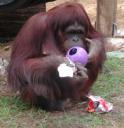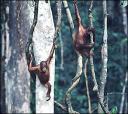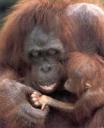 This is Radcliffe when he arrived at the Center for Great Apes in Florida. He was too thin and had very little hair. Obviously, he was not well physically nor psychologically.
This is Radcliffe when he arrived at the Center for Great Apes in Florida. He was too thin and had very little hair. Obviously, he was not well physically nor psychologically.
Radcliffe was born on February 18, 1979 in a zoo in Ohio. Radcliffe was unlucky in that he is a cross between a Bornean orangutan and a Sumatran orangutan. This fact probably was why he was sold to a circus trainer as a baby.
Thus began his entertainment career. Yes, he was a television personality and he also had to perform for small traveling circuses during his early years (when he should have been with his mother).
You’ll NEVER guess what happened? Of course, Radcliffe became too large for the trainers to handle safely. He was sold to another zoo in New York and then to a roadside attraction in Florida. He was almost to his final and best home he could imagine.
The roadside attraction closed and thankfully the Center for Great Apes was able to rescue him from his years in small cages.
 Radcliffe now gets to climb high in his sanctuary home.
Radcliffe now gets to climb high in his sanctuary home.
 He lives with another orangutan named Bam Bam.
He lives with another orangutan named Bam Bam.
And, using the wonderful Boswell Walk-About Chute System he visits all of his other orangutan friends.
 Radcliffe loves to play with all the enrichment items the center provides for him. The center makes sure he gets three enrichments a day to keep his curious mind busy. He really likes bubbles in his water and rags so he can wash down the toys, shelves and walls of his nighthouse.
Radcliffe loves to play with all the enrichment items the center provides for him. The center makes sure he gets three enrichments a day to keep his curious mind busy. He really likes bubbles in his water and rags so he can wash down the toys, shelves and walls of his nighthouse.
 This is what Radcliffe looked like after 12 months at the center. He not only looked better but he felt better.
This is what Radcliffe looked like after 12 months at the center. He not only looked better but he felt better.
Radcliffe started out life not so lucky since he was not pure Bornean nor pure Sumatran. But if he could talk now he would say how thankful he is a cross between both types of orangutans because it brought him to the Center for Great Apes his final and best home.
What can you do for Radcliffe? Donate enrichment items to the center. Check out their Wish List for items you can donate.
You can send your donations to: Center for Great Apes, Box 488, Wauchula, Florida 33873
If you want to learn more about how you can help Radcliffe and the other orangutans and chimps that the center provides permanent homes to, contact them: http://www.prime-apes.org/html/contact.html
Filed under: Orangutans, What Can You Do? | Tagged: attraction, Bornean, Borneo, Boswell Walk-About Chute System, center, Center for Great Apes, circus, donate, donations, enrichment, entertain, entertainment, Florida, home, New York, Ohio, orangutan, Rescue, roadside, sanctuary, Sumatra, Sumatran, television, trainer, transformation, Wauchula, zoo | Leave a comment »














